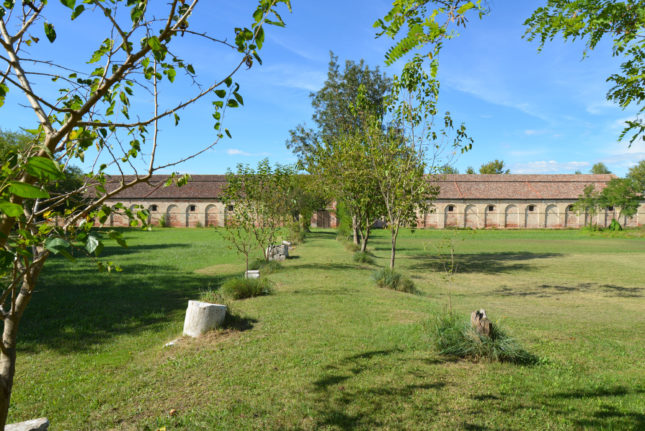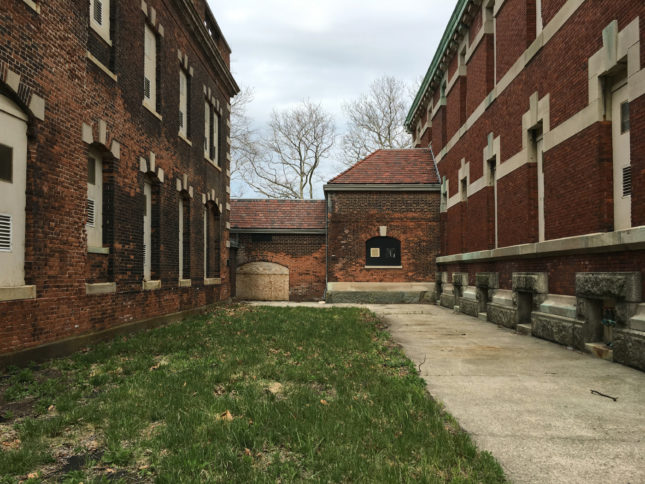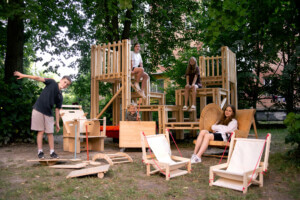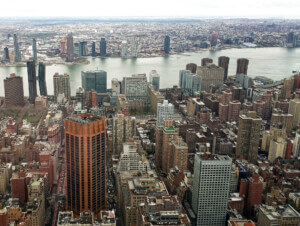Spatial investigators Geoff Manaugh and Nicola Twilley lapped the rest of the country on quarantine. The married couple was in the middle of drafting a book on the cultural, epidemiological, and spatial facets of quarantine—then titled The Coming Quarantine—when the first cases of the novel coronavirus were being discovered stateside. After Twilley returned from a business trip to Seattle in February, they both fell ill and voluntarily self-isolated in their Los Angeles home. “The next thing we knew California was under lockdown,” Manaugh recalled in a late-April interview with AN’s executive editor, Samuel Medina.
The quarantine Manaugh and Twilley anticipated—their interest in the subject goes back more than a decade—had arrived, and it’s likely to be with us for some time.
This interview has been condensed and edited for clarity.
AN: When did you begin drawing out the spatial implications of quarantine?
Geoff Manaugh: We were down in Sydney, Australia, for a temporary teaching gig, and we visited a quarantine hospital outside the city that had been converted into a luxury hotel. There was something really interesting about the fact that it had been maintained structurally and also converted into something new. The more we thought about it, the more questions we began asking ourselves: What was quarantine? Was it only a way of dealing with an epidemic disease? Where did quarantine go, and what spatial fossils did it leave out in the world for us to explore? At the time that we began looking into these questions, it still felt like a historical concern, but we soon realized quarantine is not outdated at all. Now, ten years later, with the novel coronavirus, quarantine is the only thing we have, in some ways, to protect ourselves from disease.
Nicola Twilley: We did a lot of traveling from there. For example, we went to Geneva to talk to people at the World Health Organization. They almost laughed in our faces about the idea that quarantine would be a useful medical tool—that is, using large-scale quarantine as a nonpharmaceutical intervention—in the contemporary world. At the same time, we came away with the notion that quarantine was definitely not something confined to the history books.

What outlets did you channel this initial research and travel into?
GM: As soon as we started becoming interested in [the subject], we saw that quarantine has resonances across many disciplines. For example, being in quarantine can be very interesting to a novelist, who can use the state of quarantine as the launching-off point for a novel. Or if you’re a game designer, quarantine presents a series of challenges and even [might imply] adversaries who may want to break out of quarantine. And then, of course, there’s architecture. Quarantine at its heart is an architectural, or spatial, undertaking. This became the basis for a 2010 exhibition at Storefront for Art and Architecture [in New York City] that we ended up calling Landscapes of Quarantine.
From there, you continued to look at quarantine in your own ways. Geoff, you went on to write and release A Burglar’s Guide to the City (2016), and, Nicky, you published several articles and curated an exhibition on the subject of refrigeration. What are the connections to quarantine, in each case?
GM: Both of us left the [Storefront] exhibition knowing that it deserved further exploration. Nicky was working on [the blog] Edible Geography and investigations into food, architecture, and infrastructure, and I ended up writing the burglary book. There wasn’t too much about quarantine in that book, but ironically one of the things that has come up since—and which will be in the quarantine book—is that burglary has an interesting relationship to quarantine. Unlike the lockdown we’re experiencing now, quarantine historically took place outside of the house, so that when you were placed under quarantine you were sent to a lazaretto, or dedicated facility, and often, your house was even marked, indicating that you were in a state of quarantine.…
You’re referring to the bubonic plague, the example being medieval Venice, Italy.
GM: Right, but at other points of history as well. So what that means is people who had immunity to the virus or the plague or disease that was circulating at the time, made for ideal burglars. They could easily break into the homes of those being held in the lazaretto.
This was a concern of museums [in recent months], whose lightly guarded collections, they worried, would be vulnerable to burglars, and [they] moved to hire extra security guards to ward them off. Nicky, what’s the link to refrigeration?
NT: I’m working that out in the book I’m now writing, The Birth of the Cool. You would think there would be no overlap between refrigeration and quarantine, aside from in a macabre sense, with the refrigerated trucks that hospitals are calling in right now, or the ice-skating rinks that Madrid turned to when the morgues were full. But I also think there is a conceptual overlap with quarantine, in two aspects: One, refrigeration is the most recent step in our species-long war against the bacteria that want to eat our food. We have, across time, been fighting that war with all the weapons we have had at our disposal. Quarantine is our weapon right now against the invisible bacteria and viruses that want to kill us. Two, refrigeration is a technology that has enabled us to manipulate space and time in terms of our food supply [to create] the permanent global summertime on our supermarket shelves. Similarly, quarantine is this attempt to have a seamless global trade and flow of people and goods while maintaining a barrier of health. [Refrigeration and quarantine] are both weapons and preservative acts. Of course, once you start seeing the world through the quarantine lens, it’s hard to stop.
I want to move us toward the field of architecture. I do get a sense that some architects tend to conflate the terms and the parameters of quarantine so that it becomes synonymous with isolation or simply confinement.
NT: That conflation is one that we see all the time. But there is a difference, right? With isolation, once you are certain you have the disease, then you are kept away from the rest of society. But with quarantine, there is only a suspicion that you might be infected or are a carrier for disease. There isn’t certainty, and once there is certainty, then you’re no longer in quarantine—you should be hospitalized. It’s not only architects. Throughout our reporting, everyone we talked to saw quarantine through their own lens. So if they were medical doctors, they were inclined to see it one way, and if they were historians of public health, they were inclined to see it another way, and if they were NASA astrobiologists, they saw it in still another way and at a different scale.
GM: But I do think architects are very good at assuming that a topic is unique to their discipline, when that is not at all the case. I had a similar experience when I was writing the burglary book. If I talked to an architect about burglary, it immediately seemed like a topic related to building design, but when I mentioned to a security professional or a cop that I was writing about “the architecture of burglary,” they tended to be surprised that architecture had anything to do with it. Similarly, when you talk to people about quarantine, they are surprised that there is an architecture side to it, because from their point of view it’s about law enforcement or constitutional rights or it’s about the bureaucracy involved in keeping people in their houses or even about the psychology of people and whether or not they can get through two weeks of extreme boredom staying at home. Architecture sort of stands right in the middle of all that.

Now that we’re up to speed on the history of both quarantine and your book project [which will be published by MCD Books in 2021], how will the current pandemic feature in the latter?
GM: Originally and still at the moment the book is called The Coming Quarantine [since changed to Until Proven Safe], because we imagined that quarantine really is the issue of our time. It turns out that when you take emerging diseases that don’t have a vaccine or cure and add in international air travel and the flow of goods, you can spread those emerging diseases throughout the world in the span of a few hours. So, the one thing we have left is quarantine—it’s the way we add a buffer between ourselves and everything else in order to protect ourselves. But the “coming quarantine” [that] we had projected into the future since beginning this book has arrived. At one point [during the lockdown], the majority of the earth’s population was in a state of quarantine. That is unprecedented in human history. The world itself made our book relevant, I guess you could say, because suddenly we’re writing about the present; we’re writing about something that will very likely be ongoing when the book comes out next spring.
NT: [From] our research into the historical instances of quarantine, we can see so many of the same themes today. Questions about racism and bias in how quarantine is applied. Questions about enforcement versus individual rights. Questions about inequality and what the state’s responsibility is to provide for people in quarantine and whether or not that sets a precedent for further welfare down the line. We can see these same debates happening during the bubonic plague and the resonance of people now wiping down their groceries when they get back home. At the same time, there are noticeable shifts. For example, with the predictive modeling and tracking devices, quarantine can be implemented on a massive scale and in really precise ways.
Can you give me a sense of the book’s contents?
NT: Without spilling the beans, as it were, it’s not linear. It doesn’t go from the invention of quarantine as an idea to the current day. It’s much more thematic than that. So whereas one section looks at the history of quarantine, another looks at the legal and ethical boundaries and implications of quarantine. We also have a chapter on the literary connection. It’s a progression of the many facets of quarantine, including from the perspectives of different species and at different scales.
You mentioned Sydney and Venice. What other locales figure in the book?
NT: All sorts! One of the places I visited was Reading, outside London, where the international cocoa quarantine center is. For tropical plants, the buffer zone is a nontropical country. The world trade in cacao plants is an immensely valuable industry, so to prevent diseases’ spreading from one region to another, all the world’s in-transit cacao plants go and spend a little vacation in Reading, where there are no local pests that they can pick up. It’s climatically quarantined. It’s the wrong climate zone for them, so they’re safe. There are a lot of weird places like that where you wouldn’t think to look for quarantine, yet they illuminate aspects of trade and how these “disease buffers” are engineered.
GM: Along those same lines, we went to an agricultural inspection station for plant quarantine on the Arizona-California border. We even visited NASA and the European Space Agency. We’ve been to the first federal quarantine facility in the United States. Maybe the most fun part of the book was that we were able to take a little more than a month to travel all along the Adriatic and Mediterranean Seas and visit some of the ruined quarantine stations that I mentioned earlier, these unbelievably beautiful fortified buildings dating back half a millennium, many of which are in a state of ruin or have since been converted for other uses.

I want to pick back up on the literary dimension, especially in regard to BLDGBLOG [the loosely architectural blog Manaugh founded in 2004]. Geoff, I know in those early years, [the novelist J. G.] Ballard was a presiding presence over the blog. The descriptor “Ballardian” really seems to sum up the present dystopian moment.
GM: Definitely. Quarantine is, as we were talking about earlier, a spatial problem, but it’s also a narrative problem. You’re trying to prevent two things from influencing one another, and you’re trying to keep two things separate. So right off the bat, there’s a tension that sets up influence versus contamination, containment versus escape. Almost every news item I see, I think, “Wow, that would make an amazing novel, or at least a short story.” People on an island off the coast of Maine, for example, cut down a tree and blocked a driveway, holding rifles, to make sure people stayed in their homes. That alone could set up the beginning, or for that matter, the tragic end of a film. We also see it in works like “The Masque of the Red Death,” by Edgar Allen Poe, but also in horror films. The word “quarantine” itself implies a state of horror or terror.
But in terms of Ballard, there is a great moment in his novel Super-Cannes [2000]—about a business park in the South of France—where one character says in a throwaway line that they’ve run a new simulation that requires them to set everyone’s office chairs 16 inches farther apart than they were before, so as to avoid [workers] breathing in any diseases. In that example, Ballard puts diseases at the center of how we build and the way we inhabit buildings, so that something as marginal as spacing office chairs 16 inches apart might keep SARS or COVID-19 at bay.

We can’t talk about quarantine now without also talking about social distancing, which, I guess, is a sort of interpersonal “buffer,” as you’ve put it. Initially, there had been a concern on the part of activists about relinquishing public space and, by extension, the right to protest. But, thankfully, that concern now appears to have been unwarranted.
NT: There was an amazing image of [the first] socially distanced anti-Netanyahu protests in Tel Aviv. In a weird way, it was all the more powerful because of the geometry of their distance. I also think the image of people lining up to vote in [the] Wisconsin [Democratic primary in early April], to exercise their civic responsibility despite the absolute ridiculousness of their elected representatives and still doing so in a socially distanced fashion, was incredibly powerful. So I think for every image of an Astroturfed protest [like those of late April that protested state and municipal lockdowns] there are counterimages showing that the occupation of space can be just as powerful as before.
What about this time of quarantine has surprised you the most?
NT: Even while we were doing our research, people expressed some dubiousness that Americans would agree to measures like this. That is, they could see social distancing and other measures to prevent the spread of a virus being implemented elsewhere, but not here. I have been personally surprised that, apart from those Astroturfed protests, there has been a relatively large and unquestioning participation here.
GM: I agree. I was pleasantly surprised just how willing Americans were to go along with social distancing and stay-at-home orders. They were putting country before self, and that isn’t much of a tendency you see in the United States anymore.
Following the protests across the country against police violence in late May and early June, AN followed up with Manaugh and Twilley for their response:
GM: In terms of the recent protests, both Nicky and I are resolutely in favor of police reform, against police brutality, and stand with Black Lives Matter. Purely in terms of social distancing, and not in terms of the protests’ underlying cause, I am concerned that there will be a spike or surge in coronavirus cases coming from this. I am also worried that the perceived legitimacy of future lockdowns will have suffered a political blow, as groups might violate social distancing rules or quarantine orders if it is for an issue that they believe is more important than disease containment. The flipside, of course, is that if there is not a surge in new infections, then my worry, perversely, is that the medical establishment will experience an unparalleled crisis in public trust. Had they been wrong about social distancing and quarantine all along?
I think, more interestingly, we are perhaps seeing how COVID is transforming cities by opening up streets for people, not cars, and that this gives us an early glimpse of how urban transformations such as these might empower citizens to elevate their voices and participate directly in the governance of society; it does not seem to be a coincidence that these protests are at their most successful and widespread at the exact moment that cities are being redesigned, however temporarily, for better access to urban space.










